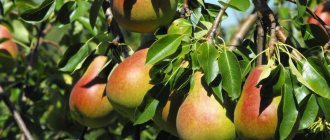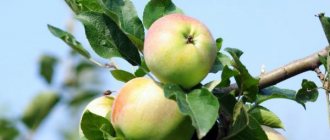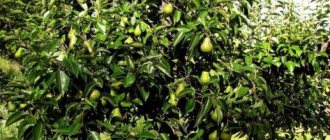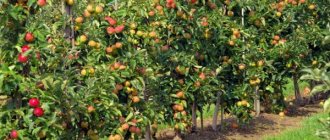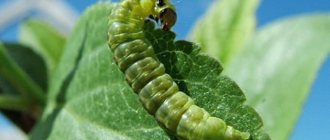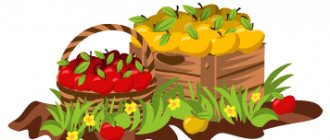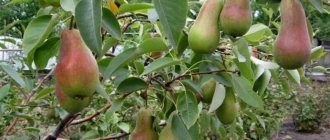The Florina apple tree is the result of the work of French breeders, who in the 70s of the last century gave gardeners a new immune winter variety, and consumers a new taste and aroma.
The history of gardening remembers that at this time scab was rampant in the gardens of Europe. The chemical industry did not have time to develop means of control - new generations of fungal disease appeared much faster.
Fortunately, on the basis of the traditional varieties “Jonathan”, “Rum Beauty”, “Golden Delicious”, as well as its clones, a new variety was developed, practically immune to all the then known five races of scab and even powdery mildew.
Description
Florin's apple tree turned out to be a medium-sized tree with a dense, wide crown.
The branches are strong, the angle of departure from the trunk is from 45° to almost a right angle. On ordinary vigorous rootstocks, the apple tree easily grows to almost 5 meters in height.
Young trees tend to thicken their crown:
- Pruning only encourages further growth.
- The buds have a medium degree of excitability - the tree recovers quite easily through dormant buds.
Flowering of “Florina” occurs in the middle period and lasts a long time - up to 2 weeks. This is very convenient, since the variety is self-sterile , and for pollination there will always be an apple tree blooming nearby.
This is interesting! Fruits begin to bear at 4-5 years (on a regular rootstock).
The first harvest is up to 10 kg, but at the age of 10 it is already up to 50 kg. Apples ripen by October:
- All of them are approximately 125-150 grams,
- One-dimensional with a dense striped blush over a pale yellow base.
- The fruits are covered with a waxy coating, which gives the red tone of the apples a purple tint, see description, photo in Fig. 1.
Fig.1. The fruits of the Florina apple tree have a waxy coating and a purple tint.
additional characteristics
There are no ideal varieties, if only for the reason that it is impossible to meet universal requirements.
Advantages and disadvantages
The main advantage of the Florina apple tree variety:
- Persistent immunity to powdery mildew and most scab races . This alone significantly reduces the cost of cultivation, and the yield of the variety only contributes to its spread in industrial horticulture.
Signs of scab.
- It is important that the variety has good transportability and beautiful appearance.
Of all the varieties of winter consumption, these apples are harvested already in September , and they can be eaten immediately, and by January they acquire additional taste and aroma.
Main disadvantage:
- The frequency of fruiting, but correct agricultural technology successfully solves this problem.
The pros and cons are approximately balanced, the variety can be classified as a “golden mean” , the average resistance to drought and frost only confirms this.
Tree height
The height of the apple tree depends primarily on the rootstock.
The variety is also grafted onto vigorous rootstocks (such as “Antonovka”) - the apple tree grows higher than 4-5 meters.
Such a tree can grow near a house, but it is in no way suitable for industrial production of marketable apples, despite the yield of up to 250 kg per tree.
Gardens of agricultural enterprises usually use the cultivation of fruits on dwarf and semi-dwarf rootstocks.
Important! Even on a semi-dwarf apple tree, the “Florina” apple tree can grow up to 3 m, and on a dwarf tree it never grows lower than 1.75 m.
Crown width
The varietal feature of this apple tree is:
- Wide, rounded crown, prone to thickening.
- Skeletal eyelids are durable. They are located at an angle to the main conductor from 45 to almost 90 degrees.
Annual growth
"Florina" refers to varieties of medium vigor:
- The annual growth of shoots is usually 40-60 cm.
- Young apple trees are characterized by high activity of shoot formation.
The level of reaction of the buds to external influences is average (for example, when freezing occurs, “sleeping” buds will wake up and the tree will quickly recover).
The growth of shoots is usually 40-60 cm.
Leaf color and shape
Like all cultivated apple trees, “Florina” has whole, ovoid leaves on a small petiole:
- The base of the leaf is rounded.
- The leaf has a short tip.
- The edges of the sheet are almost smooth.
- The leaf blade is green, pubescent underneath.
Trunk color
The standard branches and trunk of “Florina” are dark gray, like most cultivated apple trees.
A change in bark color indicates either:
- About age-related changes in a tree (its old age),
- About the development of any disease.
A criterion for the health of a tree can be considered smooth bark without visible cracks or other damage.
Productivity
After planting, the Florina apple tree seedlings begin to bear fruit :
- On a weak-growing rootstock (dwarf) for 2-3 years,
- On a medium-sized rootstock (semi-dwarf) for 4-5 years,
- On a vigorous rootstock - after 7 years.
Typically, “Florina” is not grafted onto seedlings of tall varieties.
- The first stable harvest is small, usually from 5 to 10 kg per tree, obtained in the 5th year of planting.
- With proper care, a 10-year-old tree can produce from 50 to 70 kg of fruit of excellent quality.
Tasting assessment
"Florina" is grown exclusively for fresh consumption .
Among all the winter apples, this is the only variety that you can happily eat straight from the branch; it does not need to be “aged.”
Tasters rate the taste of apples of this variety as a “four plus” - 4.2-4.5 points out of 5 possible.
At first, the fruits have a sweet taste with a slight sourness. During winter storage they become even sweeter and acquire a “melon” aroma .
Winter hardiness
The winter hardiness of the variety is very average, since it was bred by breeders for the climatic conditions of Central Europe (the birthplace of the variety is France).
The drought resistance of the variety is also assessed as average, quite acceptable for the Middle Zone.
Disease resistance
When breeding Florina, special attention was paid to disease resistance. The fact is that at that time many gardens in Europe were destroyed by scab; there were 5 races of it.
Apple trees of this variety are resistant:
- To the scab (all known races),
- powdery mildew,
- Monilliosis,
- Bacterial burn.
- Even aphids do not affect it.
Attention! But there is no resistance to European cancer.
Watering
Watering an apple tree depends only on the condition of the soil. If it is hot for a long time and there is no rain, then watering is done more often so that the tree does not dry out. The soil should be checked for moisture regularly, especially when the ovaries are forming.
Watering instructions
- It is necessary to water for the first time after all the buds have bloomed.
- The second time olive harvesting occurs 2 weeks after flowering.
- 2-2.5 weeks before the fruit is harvested.
- In mid-October.
- Before wintering.
Watering rates must always be observed. The age of the tree in this lan is very important, as a mature tree needs more water. A young Florina apple tree seedling is usually watered with 5-7 buckets of water, but an adult plant absorbs about 13-14 buckets of water. Watering should be carried out so that the liquid is absorbed to a depth of 50-70 centimeters. Otherwise, the plant does not absorb moisture, since it does not reach its roots.
Note: With proper irrigation, the yield increases by 15-25%.
Reviews
In the comments of the site, visitors often leave not only questions, but also stories about their achievements and problems.
Mikhail, 42 years old, Moscow region, summer resident with 10 years of experience . “I bought a dacha recently, I was just going to relax outside the city. And suddenly I became interested in gardening. And 3 years ago, my neighbor and I stopped by a nursery - and right there we tried “Florina” from the branches, because... We found a photo and description of the variety in the literature and wanted to make sure of the taste.
I liked that you can choose a seedling according to your taste: my neighbor is fond of “columns,” but the area allows me to plant an ordinary tree. The columnar “Florina” bloomed the next year and delighted the neighbors’ grandchildren. Everything was eaten at once - what kind of storage was there...
And my first harvest this year brought more than a bucket. My wife immediately hid some of it for the New Year, on the table...”
Vladimir, 62 years old, Krasnodar region, experienced gardener. “I’ve lived all my life in Kuban, everyone has a vineyard and a garden near their house. The wonderful variety “Florina” is productive and practically disease-free. The biggest problem is not to miss when installing supports .”
Valentina, 45 years old, young grandmother, Kursk. “We have a parental home in Rylsk. For some reason, everyone around them has one “Antonovka” planted. And my father brought “Golden Delicious” and “Florina” seedlings from Ukraine a long time ago. Everyone was afraid that the varieties were non-native. The neighbors are jealous now, they ask for cuttings for grafting. There are enough apples to eat and put in the basement for the winter. The kids will be provided with apples until spring, it’s a wonderful variety.”
Fruiting of the Florina variety on rootstock M 26.
Preparing for winter
If the florina variety is grown in a temperate climate, then it is necessary to prepare the apple tree for winter so that it does not die.
- First you need to wrap the bottom of the trunk with rags.
- Then the wood is whitewashed several times. Mandatory at the end of the autumn period, and with the onset of the spring period.
- Around the tree, close to the trunk, it is necessary to mulch using foliage, which must be treated with urea.
- This is the preparation for the winter period of the Florina variety.
Features of planting and care
Landing
Deadlines
The time to plant a tree depends on the winter hardiness of the particular variety and the climate of the area. Old school gardeners had a rule that has not lost its relevance. The time of planting a fruit tree was determined by the type of fruiting.
ADVICE! For ease of memorization, we used the formula: “pome fruits in the fall, stone fruits in the spring.” Apple trees (like pome trees) are preferably planted in the fall, a month before the first frost. During this time, the root system has time to acquire small roots. The roots do not have a rest period, unlike the above-ground part of the tree.
Autumn planting is always preferable at latitudes below Moscow, where the soil does not freeze until almost December.
In more northern regions, spring planting is preferable. The apple trees simply will not have time to acclimatize to the new place and will die in the winter.
They should be planted as early as possible in pre-prepared holes.
Spring planting of seedlings requires more frequent watering, unlike autumn . Autumn precipitation completely solves the problem of supplying water to seedlings.
Technology
When choosing a location, you should remember that this apple tree can grow on almost any soil - just not acidic.
Therefore, before planting, it is better to lim the area . To plant young apple trees, spacious holes are prepared in advance and filled with organic matter and peat.
The roots of the seedlings are spread freely in the hole and covered with soil mixture.
After abundant watering, the tree trunk circle is mulched.
Distance
IMPORTANT ! The spacing between Florina trees depends solely on the rootstock used . Very often, gardeners place young trees too densely.
It’s hard to see 4-meter trees in 2-year-old seedlings, which in 10 years will compete with each other for living space and, as a result, grow even larger. There is no need to talk about the quality of the harvest.
To avoid having to “put under the knife” these fruit thickets, you should immediately think through a planting scheme.
Scheme
Planting scheme.
Depending on the type of rootstock used, apple tree seedlings are placed according to the following scheme:
- Vigorous - 6 x 4 m,
- Medium height (semi-dwarf) - 5 x 2.5 m,
- Weak-growing (dwarfs) - 4 x 2 m,
- Columnar - 2 x 0.75(0.5) m.
It is better to immediately take care of purchasing seedlings on weak-growing rootstocks than to uproot the garden after 10 years.
Free row spacing can be occupied with currants for now:
- She has no common diseases with apple trees,
- In just 10 years, her bushes will grow old and will need to be removed.
Growing
“Florina” is a winter apple variety for warm regions of temperate latitudes .
The tree is unpretentious in maintenance, since it is practically not susceptible to fungal diseases. This quality minimizes the number of chemical treatments, which reduces the cost of industrial gardening.
An apple tree shaped like a spindle.
Peculiarities include the frequency of fruiting , but this problem can be solved with special agricultural techniques:
- Yield rationing (including chemical methods),
- Proper pruning,
- Competent feeding regime.
ADVICE ! Tree overload with harvest can also be attributed to the characteristics of the variety. The problem can be solved by specially shaping apple trees in the shape of a spindle or by timely installation of supports.
Agricultural technology
“Florina” feels great on black soil and loams, but does not tolerate acidic soils at all . Therefore, using lime when planting will not harm in any case.
For planting a young apple tree:
- Prepare a pit 60 x 80 cm,
- It is filled with organic matter and peat soil.
- They drive in a peg, tie up a seedling,
- Sprinkle its roots with a mixture of soil and applied fertilizers.
- Water well and mulch.
Proper planting of an apple tree.
Adult apple trees do not have any special care requirements:
- In spring - weeding and fertilizing;
- In summer, it is necessary to loosen the top layer to supply the roots with oxygen;
- In autumn - loosening the soil and removing fallen leaves.
"Florina" is very responsive to watering , especially during fruit filling.
Pruning and crown formation
Young trees are prone to strong crown thickening; their pruning is especially carefully monitored .
The crown shape of this variety is close to spreading; branches can break off under the weight of the harvest . To prevent this from happening, thin out the crown as much as possible - the quality of the apples will only improve.
Pruning is carried out in early spring before active growth begins.
The crown is either thinned out and left to grow freely, or formed spindle-shaped .
Advice! Watch the branches while loading the crop - place supports so that the load of apples does not break the tree.
Pollinator varieties
Unfortunately, the variety requires pollination . If you let the process take its course (free pollination), then up to 25% of the fruits are set.
It’s good if they grow nearby:
- "Golden Delicious" (or its hybrids),
- "Idared"
- "Liberty"
- "Gloucester".
These are the best pollinators for Florina. The percentage of ovary formation increases to 32% and there are never less than a quarter of the opened buds.
Only one variety with incompatible pollen - "Priscilla".
Apple tree variety Priscilla.
Agricultural technology
Landing location
When choosing the part of the site where the Florida apple tree will subsequently be planted, it is worth paying attention to the lighting. It needs to be sunny there. Shaded areas will adversely affect the development of the tree.
Apple tree Imrus
The roots of the variety are powerful. They need space. Therefore, there should be at least 2.5-3.5 m to neighboring shrubs or trees. The variety is not picky about the soil. It can grow both on fertile black soil and on clay soil. But it is worth paying attention to acidity. An apple tree will not be able to survive in soil that is too acidic. The best soil is neutral or slightly acidic.
Important! The Florina apple tree takes root only in well-drained soils. If groundwater flows close to the surface of the earth, then the crop is planted on a hill.
Selection of seedlings
- You need to purchase planting material only from trusted persons. Your best bet is at your local nursery. Zoned plants are sold there. The manufacturer and his products must have good reviews from gardeners;
- The best age of the plant is 1 or 2 years;
- You should purchase only a healthy seedling, without damage to the trunk and roots;
- The bark should be rough and elastic. The wood located under the bark is light green and slightly damp. If the wood is dark, the seedling will not take root.
Landing
Planting should be planned at least several months before the intended process. This is necessary to select a location and prepare a planting hole.
The material can be planted both in spring and autumn. In central Russia, autumn planting takes place from mid-September to mid-October, in the southern regions - from late September to mid-November. In the spring, you need to plant a seedling before the buds begin to swell. In the Moscow region this is done until the end of April.
Important! The planting pit is prepared in advance. The pit must be voluminous and deep. Recommended diameter - 1.2 m. Depth - 0.8 m. The soil from the pit is mixed with 3 buckets of humus. 0.5-0.8 kg of ash and 0.1-0.15 kg of potassium sulfate are added there. The substrate is placed in the planting hole. It is spilled with two 10-liter buckets of water.
If planting is planned for spring, then such work is carried out in the fall. If it is for autumn, then the planting hole is prepared at the end of summer. If the soil is acidic, then dolomite flour, chalk or lime are added to the planting hole.
Landing instructions:
- A day before placing the seedling in a permanent place, it is placed in a basin of water. This is necessary for the roots to become saturated and revived. Next, they are dipped into a mixture of clay with mullein and water;
- Part of the earth is removed from the hole. A slide forms at the bottom. A strong stake is stuck into it. Its length is about 1 m. It acts as a support;
- The roots are straightened and placed on a mound so that everyone has free space;
- The root neck should be 5-8 cm above ground level. After planting, the earth will settle and the root collar will be at soil level;
- All the earth is poured into the hole. It compacts easily. A tree trunk circle is formed into which watering will be carried out;
- It is recommended to mulch the ground under the seedling. Peat, hay, sawdust, spruce needles are suitable;
- The seedling is tied to a support and watered. 20 liters of water are used for irrigation.
Care
The Florina apple bush does not require special care. The main thing it needs is systematic watering in the first few years after planting, weeding, loosening, fertilizing, and pruning.
Watering
It should be organized every 10-14 days in the spring and summer. You cannot overwater the plant. If it rains, no additional watering is required. For a young shrub, three 10-liter buckets of water are enough, for an older tree – 8-13 buckets. As soon as the bush turns 3 years old, the frequency of watering is reduced.
Weeding
In order for the Frenchwoman to grow and develop well, it is necessary to weed the tree trunk circle. The soil should also be loosened. A pitchfork is suitable for this.
Top dressing
The varietal shrub Florina will appreciate feeding. Fertilizers should be applied carefully so as not to damage the tree’s immunity. This variety can be fertilized with a small amount of manure, spreading it over the surface of the soil, but not applying it to the trunk. In spring, it is also possible to use humus or 0.5 kg of urea.
On a note! In summer, it is recommended to feed the plant with fertilizers containing phosphorus and potassium. In the fall, the apple tree is also treated with potassium or phosphorus fertilizer along with potassium sulfate.
Trimming
In the first year, the seedling is shortened. It is necessary that a stalk 80-90 cm high remains. This is necessary to awaken the buds. In the second year, all weak shoots of the bush are cut off. Only the trunk and strong skeletal shoots are left. The task is to evenly distribute the branches of the crown. After the trunk reaches the desired height, it is cut off. You can prune an apple tree every year at the very beginning of spring or autumn. The crown is thinned out as necessary, giving it a neat, rounded shape.
Additional Information. It is recommended to cover a young apple bush before winter. To do this, the branches are wrapped in rags and burlap. Peat mixed with manure or sawdust is laid out under the roots. For an adult tree, it is enough to whiten the trunk and mulch the tree trunk area generously.
Features of ripening and fruiting
Beginning of fruiting
The aboveground and underground parts of any tree are inextricably linked, not only in the literal sense. The type of rootstock affects the fruiting of the scion , including the time at which fruiting begins.
Under equal growing conditions, “Florina” enters the fruiting stage at:
- 3 year in case of dwarf rootstock,
- 4-5 years on semi-dwarf rootstock,
- 7 years old - vigorous.
Deadlines
Blooms
The self-sterility of “Florina” is compensated by long flowering in the middle period.
Since apple trees grow everywhere, there is sure to be a blooming one nearby, and the problem solves itself.
Fruit ripening
In the central zone, “Florina” is suitable for harvesting (technical maturity) in the last days of September.
Harvest of Florina apples.
Unlike most winter varieties, these apples taste great fresh from the tree.
What is important is that these fruits hold well on the stalk even after ripening. Apples not intended for storage do not need to be removed immediately - they will only gain flavor on the branches and acquire a “florin” aroma.
Fruit storage
The whole bouquet of taste and aroma is revealed after aging” in storage only closer to the New Year holidays. Apples can be stored until March, and in the refrigerator until June.
In order to successfully preserve apples with minimal losses , it is important to follow certain rules:
- Harvest fruits for storage only at the stage of technical maturity (they fall off 5 pieces per day).
- Use gloves - apples should be as whole as possible.
- Fruit harvesting begins from the lower branches, moving gradually to the top.
- The stalk should remain with the apple.
- Do not wipe off the waxy coating.
- Place apples immediately into containers.
ADVICE ! Keep the picked apples for 2-3 weeks in a cool room, carefully sort through them and sort them by size. To store in the basement, place apples in 2-3 layers with the tails facing up.
The main requirement for containers is absolute cleanliness; the material can be any.
There is no need to cover it with paper - ventilation should be maximum.
For the refrigerator, place apples in plastic bags with slits for ventilation.
Subspecies and variants of the Florina variety
The variety of forms allows you to choose the appropriate option for each specific case.
French gardeners have received a fruit tree that can be grown in completely different forms - from a large 4-meter tree to a neat “column”.
Red
On a regular vigorous rootstock, the apple tree reaches a height of 4 meters. Such a tree creates many problems .
Moreover, pest control and pruning are far from the most difficult.
Branches loaded with crops must be supported or otherwise protected from breaking the trunk.
The yield of the variety creates the main problems for the gardener.
Columnar
Growing a columnar apple tree solves many problems.
Such apple trees in a row can be planted even at a distance of 0.5 m in a row with a row spacing of 1.5-2 meters.
There is always a place for such compact apple trees in any country house.
The “column” has another important advantage - it is easy to cover for the winter .
This means that the variety easily moves north in amateur gardening.
There are confirmed facts that these apple trees successfully bear fruit in the Leningrad region if the tree trunk is covered with mulch and the tree itself is wrapped in burlap or agrofibre.
Winter
Apples picked at the stage of technical maturity rarely differ in taste and aroma. But for “Florina” an exception can be made. Already at the end of September they are very tasty. Storing until the New Year holidays only gives them the characteristic “Florin” aroma of ripe melon.
Under special conditions, apples are stored until March, and in the refrigerator - even until June.
Important! The safety of fruits is influenced primarily by the technology of their collection. The slightest damage to the skin quickly leads to rotting.
Immune
The immunity of foreign apple tree varieties is an order of magnitude higher than that of domestic ones.
One of the most significant problems of the Middle Zone is regular epidemics of scab and other fungal diseases. Without repeated chemical treatments, not only the crop will die, but the entire garden.
Reducing the number of chemical treatments makes it possible to grow environmentally friendly apples.
By planting a garden with varieties that are not afraid of fungal infections , the number of garden treatments is significantly reduced.
Not only are labor and cost costs reduced, there is now a real opportunity to grow organic fruit .
The “Florina” variety, with its resistance to scab and powdery mildew, when grown on dwarf rootstocks and in the form of columns, can provide not only amateur gardeners with tasty winter apples.
Folk remedies against spiders
In addition to industrial chemicals, some folk remedies can also be used to combat arachnids in an apartment. These measures do not have scientific confirmation, but they are quite simple and give the desired effect.
It has long been noted that spiders do not like strong odors and live in dry and warm rooms. Therefore, the following control methods can be used.
- Hazelnuts, chestnuts, and Osage oranges are believed to repel spiders with their scent. The above fruits can be broken or crushed to release the odor and placed in areas where arthropods congregate.
- Spiders cannot stand the smell of peppermint. You can add a few drops to a spray bottle and spray around the apartment. Such aromatic procedures should be carried out regularly. You can also try tea tree or eucalyptus oil. They also have a fairly pungent odor that will repel spiders.
- To combat, you can use diatomaceous earth, which is scattered in a thin layer along the baseboards around the perimeter of the room. Crossing such an embankment, the spider is cut into two parts and dies very quickly.
- Vinegar is also a good repellent for these animals. You can spray it around the room or place it in the corners of a saucer with water and a few drops of acid.
People associate the appearance of arthropods with various signs and superstitions, for example:
- Seeing a spider in the morning is good luck, in the afternoon it means great love.
- If a spider hangs on the web in the table area, it means betrayal.
- A spider fell on its head - to unexpected profit.
- Seeing a spider pulling itself up on a web is good news.
- A cobweb over the bed means betrayal or health problems.
In Russia, most spiders are harmless. And if they appear on a plot or in a greenhouse, they are even useful, since they eat pests and their larvae. Whether to fight arthropods or not is an individual question.
We suggest you read How to get rid of bedbugs in an apartment
You can get rid of house spiders using simple, affordable means. Arthropods are afraid of certain odors. A person does not feel repellent aromas or they are pleasant to him.
- Chestnuts, hazelnuts, and orange peels will help remove spiders from the apartment and prevent them from entering. Place it in the corners of rooms, behind furniture, on the windowsill. The method is convenient because you do not have to repeat the procedure often; the protection can remain in place for six months, as long as there is a possibility of arthropods entering the house.
- Essential oils help fight spiders. Use lavender, rosemary, lemon balm, mint, geranium, lemon. Soak the cotton wool and place it in all places where unwanted guests might settle. Or prepare a solution - dissolve essential oils in water and pour into a spray bottle. Every week during cleaning, window sills, corners of rooms, and baseboards are sprayed.
- Spider repellents in private homes are prepared using vinegar and ammonia. Used when you need to instantly expel arthropods. Add vinegar or ammonia to the water - a tablespoon per 1 liter of liquid. The solution is used to wipe the back of furniture, baseboards, and window sills.
- You can kill spiders in your home using boric acid. Sold in pharmacies in powder form. It does not smell, does not get into the air, and is safe for humans. In the house it does not lose effectiveness for about 6 months. Wash off with water. The powder is scattered along the baseboards and on the windowsill. Spray the walls with the solution. The product is suitable if you need to get rid of spiders on the balcony or outside.
Folk methods of fighting spiders All folk remedies are safe for humans and effective. The choice depends on personal preference. In late autumn, all protection can be removed, since with the onset of cold weather the arthropods die or go into suspended animation.
Growing in regions
The brainchild of French gardeners, “Florina” has very mediocre frost resistance. This indicator is decisive when choosing a variety for cultivation in Russia.
In the middle zone and Moscow region
Considering the very average indicators of winter hardiness , in the central zone north of the Moscow region it is not advisable to grow “Florina” without a special winter shelter: it is too troublesome, and the result is unpredictable.
It is better to plant a garden from reliable zoned varieties.
However, by planting this variety of French selection and reliably covering the root circle for the winter, you will get a good harvest of tasty winter apples.
The gardens of the Middle Zone suffer greatly from scab, but “Florina” is not afraid of it, as well as powdery mildew, moniliosis and fire blight. The number of garden treatments with chemicals is automatically - ecological products are now in trend.
There is one problem that gardeners do not encounter except in Russia - hares and rodents. Young trunks are tied with spruce branches and juniper, and the trunks are coated with lime with special additives.
In Ukraine
The climatic conditions of Ukraine, especially the central part (steppe and forest-steppe), differ little from France .
Winters are colder, but the temperature rarely drops below -20°C and not for long, which has virtually no effect on the wintering of fruit trees.
Usually a lot of snow falls in winter - the roots do not suffer from the cold , and in the spring the tree does not lack water.
During flowering (late May), possible frosts are unlikely; flowers and ovaries cannot be damaged in any way. During fruit loading (June-July) it often rains, but “Florina” is not afraid of powdery mildew and scab.
Story
This apple variety was developed by French scientists by crossing several varieties:
- Rum Beauty;
- Golden Delicious;
- Jonathan;
- Starking.
In Russia, the variety became known only in the 70s, quickly gained popularity and began to be used for industrial purposes.
